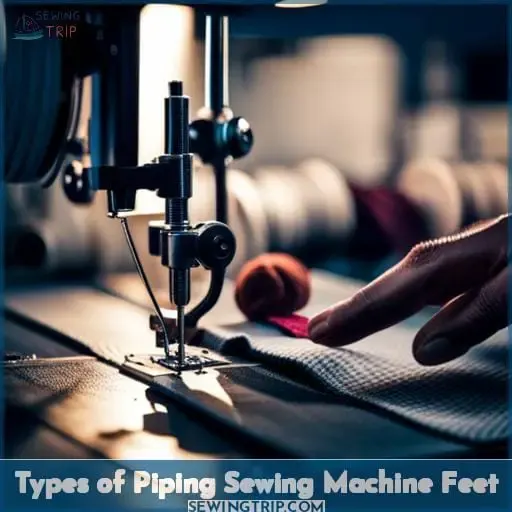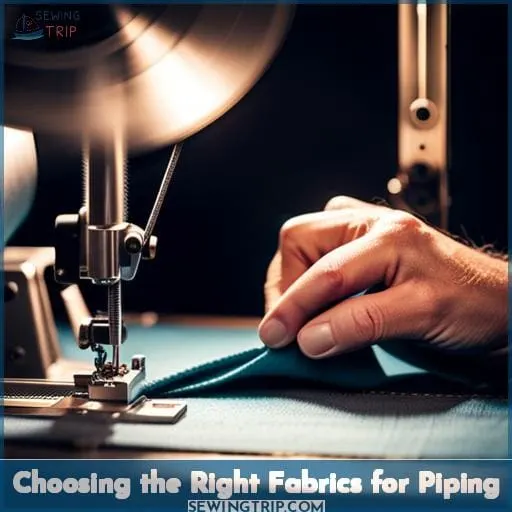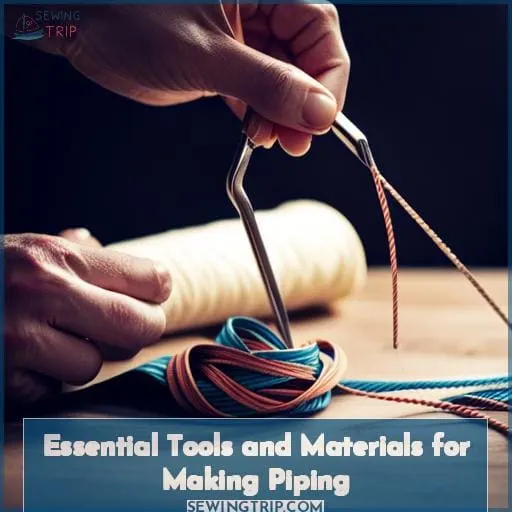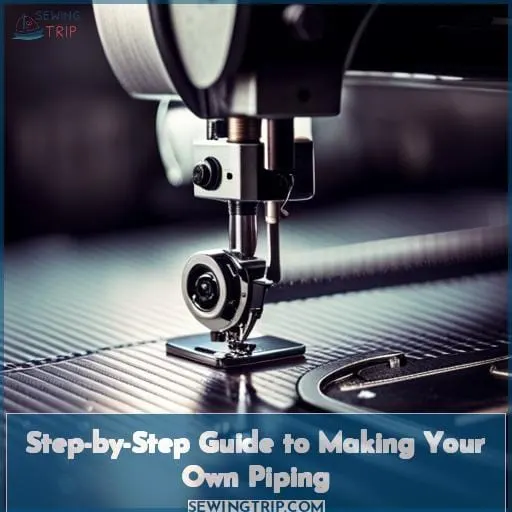This site is supported by our readers. We may earn a commission, at no cost to you, if you purchase through links.
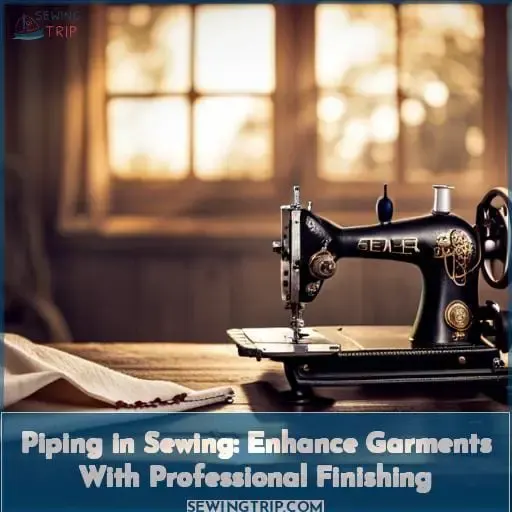 Are you eager to hone your sewing skills and take them to the next level? Then it’s time for you to learn about piping in sewing!
Are you eager to hone your sewing skills and take them to the next level? Then it’s time for you to learn about piping in sewing!
Piping is a strip of fabric folded over a cord that is used as an embellishment or trimming on garments. It can be used for both decorative and practical purposes, giving clothing items a professional finish, enhancing garment shape and adding creative color choices.
In this article we will discuss the basics of what piping in sewing entails:
- From types of machine feet suitable for attaching it,
- Through choosing fabrics best suited for making/working with piping,
- All the way up to essential tools needed when working with this technique.
So let’s get started – read on if you want to join us now!
Table Of Contents
- Key Takeaways
- What is Piping in Sewing?
- The Benefits of Using Piping in Sewing Projects
- Types of Piping Sewing Machine Feet
- Choosing the Right Fabrics for Piping
- Essential Tools and Materials for Making Piping
- Step-by-Step Guide to Making Your Own Piping
- Tips and Tricks for Neat Piping
- Creative Ways to Use Piping in Sewing Projects
- Conclusion
Key Takeaways
- Piping in sewing involves adding fabric trim over cord for embellishment. Piping serves both decorative and practical purposes. Medium-weight cotton fabrics work well for piping, as lightweight fabrics should be avoided. Piping applications include slipcovers, pillows, cushions, and garments.
What is Piping in Sewing?
Piping adds a tailored detail to your sewing project by folding fabric over cord to make decorative trim. The piping technique involves folding bias or straight-grain fabric around cording, then stitching close to the cord for a professional finish.
For piping, choose medium-weight cottons rather than lightweight or stretchy fabrics.
Apply piping to edges and seams of slipcovers, pillows, cushion trim, garments, and more for aesthetic shaping. Get creative with piping by varying cord sizes and fabric colors or patterns. With practice, you’ll achieve neat, accurate piping that takes your sewing projects to the next level.
Consider fabric selection, ideal seam allowance, and clipping curves to master this decorative detail that adds polish. Medium-weight cottons are better than lightweight or stretchy fabrics for piping.
Fold bias or straight-grain fabric around cording, then stitch close to the cord. Use piping on edges and seams of projects like slipcovers, pillows, cushions, and garments. Vary cord size and fabric colors or patterns to get creative. Practice helps achieve neat, accurate piping for polished sewing projects.
The Benefits of Using Piping in Sewing Projects
Adding piping to your sewing projects provides many benefits. Piping enhances the shape of garments, adds a professional finishing touch, and allows for creative color choices – just a few ways this detail can elevate your sewing.
Sewing piping into your projects allows you to accent seams and edges with a colorful pop of fabric. Strategically placed piping can also highlight the silhouette of a garment, drawing the eye to style lines and adding contour.
The professional polish piping lends to home décor and apparel makes it an excellent way to take your sewing up a notch. Piping offers the chance to incorporate a contrasting color that coordinates with your main fabrics without the commitment of an all-over print or texture.
This versatile trim can be sewn into anything from pillows to garment seams for a custom couture look. Whether you’re completing a simple project or advanced piece, consider adding piping for enhanced shaping and style.
Enhancing garment shape
You’ll tailor your garments’ shape by carefully folding piping and sewing it into seams. Even if you’re new to piping, embracing this tricky technique will pay off with padding-free definition. Strategically placed piping molds garments to your form, adds shape at the waist or hips, and sculpts sleeves or bodices without altering the fabric.
Play with piping widths and colors to make subtle enhancements or bold accents. With practice, piping gives you limitless options to shape garments for a perfect fit.
Professional finishing touch
However, piping gives your projects a polished, professional finish. The tailored detail lifts any sewing project and makes it look store-bought.
- Defines edges and accents
- Enhances structure
- Provides contrast
- Focuses the eye
- Makes amateur work look professional
Creative color choices
Piping brings out the creative side of you. With piping, the fabric pairing possibilities are endless. Experiment with complementary, contrasting, or matching hues for that perfect stylish accent. Creative piping invites you to get inspired, play with color combinations, and make each project uniquely your own.
Types of Piping Sewing Machine Feet
You’re going to love experimenting with all the piping feet that make it so much easier to get perfect results. From basic zipper feet to specialty piping feet, having the right tool for the job takes the frustration out of the sewing process.
Get extra close to the cording for precise stitching with a piping foot. The groove along the bottom lets the cording glide smoothly under the foot.
Play around with different feet from your local fabric store to find what works best for your project.
Having options opens up creativity. With the perfect piping foot, you’ll get professional, consistent results every time.
Choosing the Right Fabrics for Piping
When starting a new sewing project featuring piping, carefully consider your fabric choices. Opting for fabrics like bleached drop cloth, cotton quilting, or linen will make working with piping much easier.
It also allows creativity with color combinations and piping placements for a professional finish.
Suitable fabric choices
Instead of lightweight fabrics, choose medium-weight cottons for piping so it holds its shape when stitched. For example, a quilted table runner looks more professional with piping made from cotton shirting rather than voile.
Duck canvas, bleached drop cloths, and 100% cotton quilting fabrics make excellent piping. They’re easy to shape, take tension well, and give a crisp finish. Be sure to preshrink your piping materials too – it helps prevent puckering when stitched.
With the right fabrics, you can add beautiful piping detail to any sewing project.
Tips for working with piping
Once you’ve chosen the fabric, be sure to preshrink it so the piping stays smooth. Take your time stitching piping – slow and steady wins the race. Keeping the needle close to the cord creates professional results.
Allow extra seam allowance when sewing corners. Experiment with contrasting piping colors for a creative pop. Matching thread helps piping blend seamlessly into the project. With practice, you’ll master the art of neat piping.
Creative uses for piping
Accent chairs with contrast piping show off your vision.
- Add piping to chair seat cushions for definition.
- Pipe the edges of throw pillows in coordinating colors.
- Showcase your style with piped curtain headers.
Piping accents demonstrate your creative spirit and skill. Play with contrasting piping colors and placements to reflect your unique personal flair.
Essential Tools and Materials for Making Piping
You’ll need cotton piping, a zipper foot, fabric, a basic sewing machine, and matching thread, right? Before making piping, gather your essential tools and materials. Choose a firm, tightly woven fabric in a weight that suits your project – stay away from flimsy or stretchy options.
Preshrink your fabric and cord to prevent shrinkage issues later. Opt for all-cotton cord in a size that matches the piping’s intended use.
A basic sewing machine and zipper foot are must-haves, allowing you to stitch close to the cording for a professional finish.
Taking the time to prepare your piping materials will lead to success in achieving neat, polished results that elevate your sewing projects. With some practice and the right supplies, you’ll be piping like a pro in no time.
Step-by-Step Guide to Making Your Own Piping
Let’s get started. Fold your fabric strip over the piping cord. Then sew the cord into the fabric strip using a zipper foot, keeping the needle close to the piping for a professional finish.
Cutting the Fabric Strip
When cutting the fabric strip, keep a steady hand and clear mind for precision. Align the strip smoothly along the edge of your fabric for even length. Aim for 3-5 inches in width depending on the intended cord thickness and project type.
Take care to cut on grain for straight piping or on the bias for flexibility. Use sharp fabric scissors and a rotary cutter for clean, accurate cuts.
Folding and Sewing the Piping
Now take the fold and sew the cord inside, keeping your needle so close you can barely see it peeking through.
- Be patient and take it slowly to avoid breaking needles on the cord.
- Preshrink the fabric and cord to prevent future wrinkling.
- Use a zipper foot for the best piping results.
- Try different cord sizes and fabrics for creative effects.
- Perfect piping takes practice – don’t get discouraged!
With attention and care, you’ll achieve professional-looking piping to elevate your sewing projects.
Joining Piping Ends
Once the piping is finished, align the ends at a 90-degree angle and stitch them together neatly. Use piping joining techniques like overlapping or mitering for seamless results. To create a clean finish, trim excess fabric from the seam allowances and press them open.
When turning corners, use piping corner tips by cutting diagonal slits in the seam allowance to allow for smooth folding around curves. Matching the piping pattern is important for a cohesive look, while experimenting with different colored fabrics adds unique flair to your projects.
Tips and Tricks for Neat Piping
Getting the needle as close as you can to the piping gives it a professional look.
- Shorten your stitch length. This allows for easier removal if a stitch is off.
- Invest in quality needles. They will make precision easier.
- Try a zipper foot. It lets you stitch closer to the cord.
- Go slow, especially around curves and corners. There’s no rush for neatness.
- Maintain tension to prevent puckering. A walking foot helps.
With practice using these tricks, you’ll have the skills to make polished piping in creative colors to elevate your sewing projects. Take your time and don’t get frustrated. Patience and persistence pay off for beautifully finished piping.
Creative Ways to Use Piping in Sewing Projects
Hold on tight, folks, ’cause this piping express is about to transport your sewing to sensational new destinations!
Dresses: Contrast piping on pocket edges or accent seams adds detail without overpowering.
Pillows: Piping on edges or as embellishment defines shape and elevates look.
Bags: Piping on handles, edges, pockets provides sturdy detail and customization.
Curtains: Piping along top edge or side seams gives a tailored finish and visual interest.
Let your imagination run wild with creative piping uses! It’s such a versatile embellishment for both fashion and home decor. Play with piping placement, colors and textures to make ordinary projects extraordinary.
Conclusion
Piping in sewing is a great way to add decorative detail. It helps enhance garment shape and give a professional finishing touch. With the right fabric and tools, you can easily make your own piping for creative color choices not found in stores.
Bleached drop cloths and 100% cotton quilting fabrics are excellent choices. With a zipper foot, fabric, and thread, it’s simple to make custom piping.


